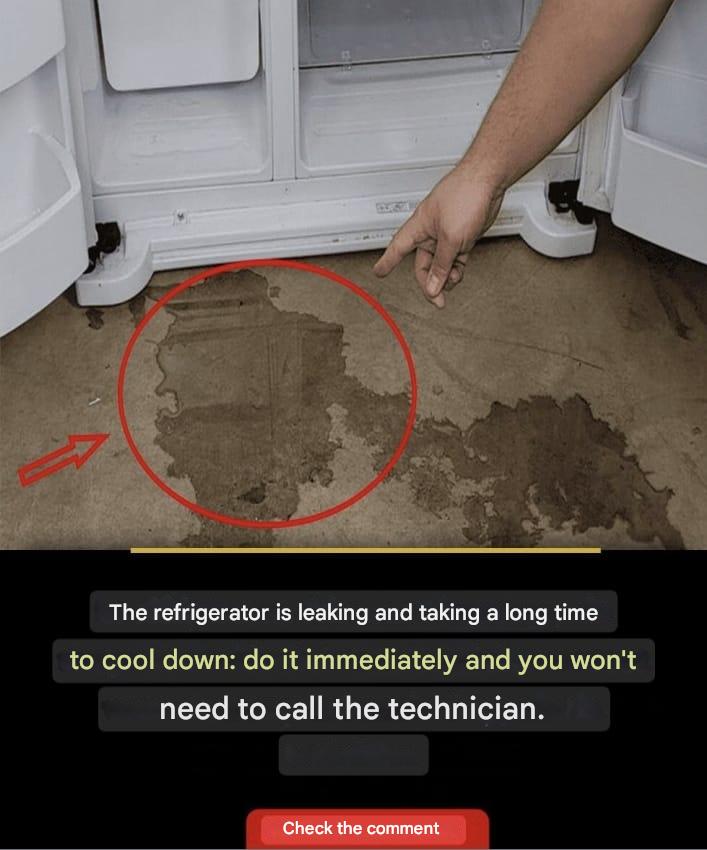ADVERTISEMENT
Leaking Refrigerator and Takes a Long Time to Cool: Do It Immediately, and You Won’t Need to Call the Technician
A leaking refrigerator that takes too long to cool is not only frustrating, but it can also lead to higher energy bills and potential food spoilage. While it may seem like a complicated issue that requires a technician’s help, often times the problem can be fixed with some simple troubleshooting and maintenance. Before picking up the phone to call a professional, take a moment to try these quick and easy steps. You may save yourself both time and money!
Why Is Your Refrigerator Leaking and Taking a Long Time to Cool?
Before we dive into how to fix the issue, it’s important to understand why your refrigerator might be experiencing these problems. Common causes include:
- Clogged or Frozen Defrost Drain: If the defrost drain is clogged or frozen, water can pool at the bottom of the refrigerator, leading to leaks.
- Dirty Condenser Coils: If the condenser coils are dirty or covered in dust and grime, they can’t effectively release heat, making it harder for the fridge to cool down.
- Faulty Door Seals: Worn-out or broken door seals can let warm air in, making it harder for the refrigerator to maintain a cool temperature.
- Blocked Vents: Air vents inside the fridge can become blocked with food, preventing proper airflow and leading to longer cooling times.
- Thermostat Problems: If the thermostat is malfunctioning, it may not signal the compressor to kick in and cool the fridge properly.
Now that we know the potential causes, here are a few steps to take to solve the problem and prevent future issues.
1. Check for Clogged or Frozen Defrost Drain
One of the main causes of a leaking refrigerator is a clogged or frozen defrost drain. This drain allows excess water to flow out of the fridge when it goes through a defrost cycle. If it gets blocked, the water backs up and can leak inside the fridge or under the unit.
How to Fix It:
- Locate the Drain: Find the defrost drain, which is usually located at the bottom of the fridge or freezer section. In some models, it may be behind a panel or cover.
- Clear the Clog: Use a small brush or a pipe cleaner to remove any debris from the drain. If you notice a frozen blockage, pour warm (not boiling) water down the drain to clear it.
- Use a Wet-Dry Vacuum: If water has accumulated, use a wet-dry vacuum to suck up the excess water.
2. Clean the Condenser Coils
Dirty condenser coils are one of the main reasons why your fridge might not be cooling efficiently. These coils release the heat from inside the refrigerator, and if they are covered in dust, dirt, or pet hair, they can’t function properly.
How to Fix It:
- Turn Off the Refrigerator: Always unplug the fridge before cleaning.
- Locate the Coils: On most refrigerators, the condenser coils are located either at the back or beneath the appliance.
- Clean the Coils: Use a coil brush (or a vacuum with a brush attachment) to gently remove dust and dirt from the coils. Make sure you get into all the nooks and crannies. If necessary, use a damp cloth to wipe down the area.
- Reconnect and Test: After cleaning, plug the fridge back in and check if the cooling efficiency improves.
3. Inspect the Door Seals
If your refrigerator door seals are damaged, they won’t close properly, allowing warm air to enter the fridge and preventing it from cooling efficiently. This can also lead to condensation and water leaks.
How to Fix It:
- Examine the Seals: Look closely at the door seals for any cracks, tears, or areas that might be loose.
- Test the Seal: To test the seal, close the door on a piece of paper. If you can easily pull the paper out, the seal isn’t tight enough and needs to be replaced.
- Clean the Seals: Sometimes, dirt can cause the seal to break or not close properly. Clean the seals with warm water and mild soap to ensure they’re functioning well.
- Replace the Seals if Necessary: If the seals are damaged or worn out, order a replacement from the refrigerator manufacturer or your local appliance store. Replacing the seals is usually a simple task and can be done without professional help.
4. Clear Blocked Vents
Your refrigerator works best when air can flow freely through the vents inside the fridge and freezer. If the vents are blocked by food items or ice buildup, it can cause the fridge to take a long time to cool.
